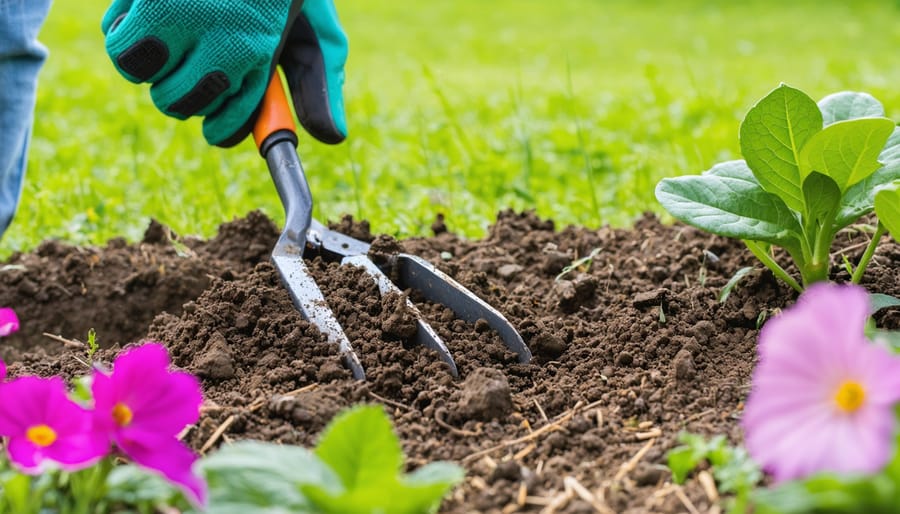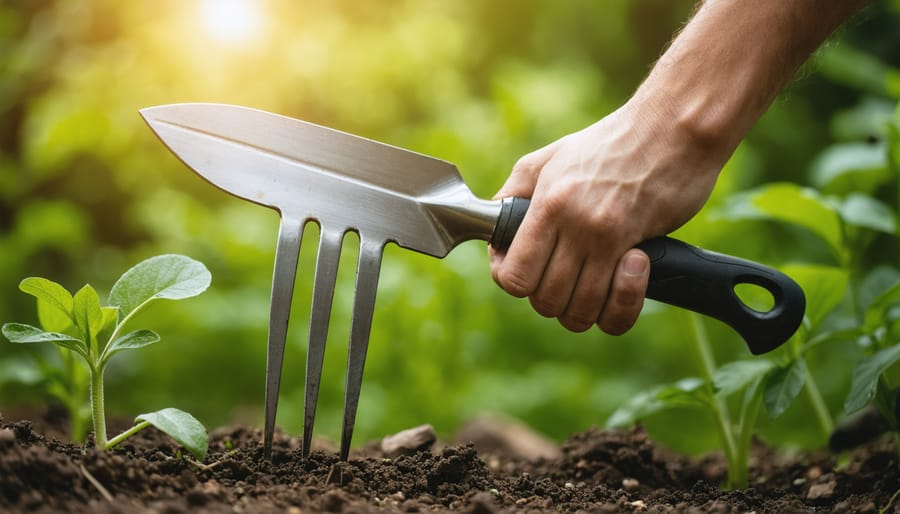Transform your garden’s productivity with the cultivator – a versatile 3-pronged hand tool that ranks among the most essential gardening tools for any serious gardener. This classic implement, also known as a garden claw or hand fork, excels at breaking up compacted soil, removing stubborn weeds, and aerating garden beds with remarkable precision. Whether you’re preparing soil for spring planting, maintaining established beds, or cultivating around delicate plants, the three-tined design provides the perfect balance of power and control. Modern versions feature ergonomic handles, rust-resistant materials, and specialized prong configurations that make this time-tested tool even more effective for today’s gardening challenges. Discover why generations of gardeners have relied on this indispensable tool to create thriving, healthy gardens with minimal effort and maximum results.
Understanding Your 3-Prong Cultivator
Anatomy of a Quality Cultivator
A quality three-prong cultivator consists of several key components that work together to make your gardening tasks easier and more efficient. The tines, typically made of rust-resistant steel or carbon-coated metal, should be sturdy yet flexible enough to move through soil without bending or breaking. Look for tines that are at least 6-8 inches long with pointed tips for optimal soil penetration.
The handle is equally important – it should be comfortable to grip and made from weather-resistant materials like hardwood or ergonomic rubber-coated metal. The best cultivators feature a handle length that allows you to work without straining your back, usually between 12-15 inches for hand tools or 48-54 inches for long-handled versions.
The connection point between the tines and handle needs to be robust, preferably featuring a solid metal ferrule or welded joint. This prevents wobbling and ensures the tool maintains its integrity even during heavy use. Quality cultivators also have tines spaced about 2-3 inches apart, providing the perfect balance between soil coverage and ease of movement.
Weight is another crucial factor – aim for a tool that feels substantial enough to dig effectively but light enough for extended use without fatigue.
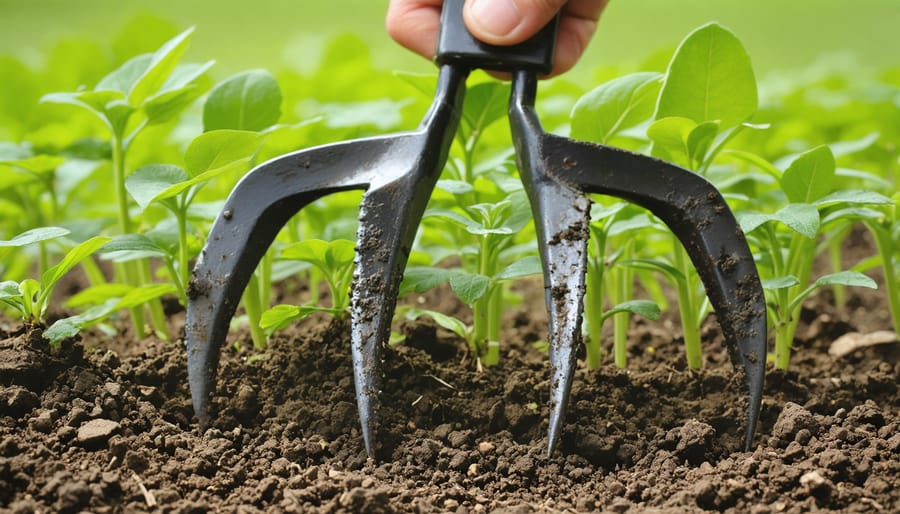
Different Types and Variations
Three-prong garden tools come in various designs to suit different gardening needs and preferences. The most common variation is the hand-held cultivator, which typically measures 10-12 inches in length and is perfect for working in small spaces or container gardens. These compact tools offer excellent control for precise work around delicate plants.
For those who prefer to work without bending, long-handled versions extend anywhere from 3 to 5 feet, making them ideal for maintaining larger garden beds while protecting your back. Some models feature telescoping handles that adjust to your preferred length, offering the best of both worlds.
Materials also vary among different models. Traditional tools are often made with sturdy carbon steel tines, while modern versions might feature stainless steel or aluminum for rust resistance and lighter weight. Some premium models even incorporate ergonomic handles with non-slip grips and cushioned materials for added comfort.
You’ll also find specialized designs with curved tines for better soil penetration, adjustable width between prongs, or even interchangeable heads that allow you to switch between different tine configurations based on your task at hand.
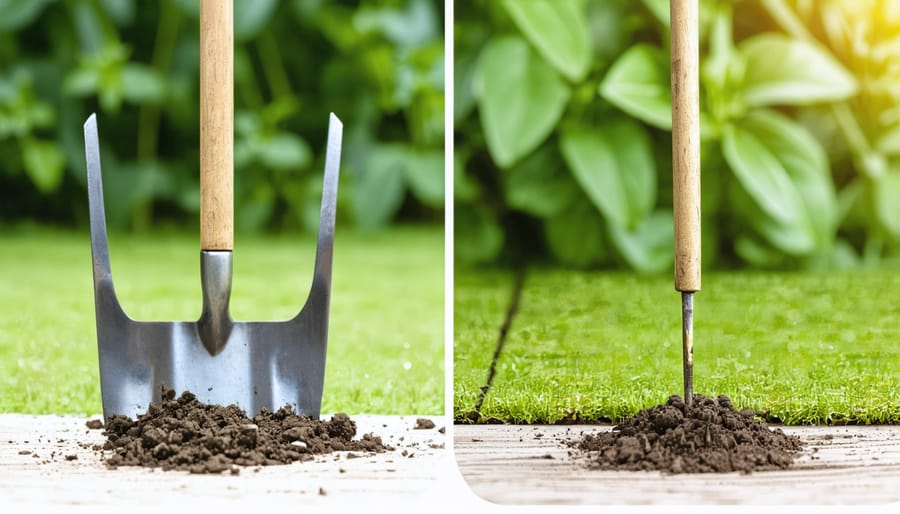
Primary Uses in the Garden
Soil Preparation and Aeration
The 3-prong garden tool excels at breaking up compacted soil and improving drainage, making it an essential companion for any gardener. By implementing proper digging techniques, you can maximize this tool’s effectiveness in your garden beds.
Start by holding the tool at a 45-degree angle and push it into the soil using your body weight rather than just arm strength. Work in a systematic pattern, creating holes about 4-6 inches deep and spaced roughly 6 inches apart. The three prongs efficiently break up soil clumps while creating channels for water and air to penetrate deeper into the ground.
For best results, use the tool when soil is slightly moist but not waterlogged. This makes penetration easier and prevents soil compaction. As you pull the tool back, give it a gentle wiggling motion to further loosen the soil structure. This action creates vital pathways for root growth and helps earthworms move more freely through your garden bed.
In clay-heavy soils, you might need to make multiple passes, working from different angles to achieve optimal aeration. Remember to clean the prongs after each use to prevent soil from hardening between them.
Weed Management
A 3-prong garden tool excels at weed management thanks to its versatile design. The three tines can easily slide beneath weed roots, loosening them from the soil with minimal disruption to nearby plants. For best results, work the tool around the weed in a gentle rocking motion, then lift upward to remove the entire root system.
This tool is particularly effective for dealing with deep-rooted weeds like dandelions and thistles. The prongs reach deeper than many other weeding tools, helping you extract the entire root rather than just breaking it off at the surface. To prevent weed regrowth, make sure to remove all root fragments from the soil.
For preventive weed management, use the tool to regularly cultivate the soil surface, disrupting weed seedlings before they become established. This technique, known as shallow cultivation, is especially useful in vegetable gardens and flower beds. After removing weeds, consider applying a layer of mulch to suppress future weed growth while keeping the soil moist and healthy.
Remember to work the soil when it’s slightly moist but not wet, as this makes weed removal easier and prevents soil compaction.
Mixing in Amendments
The three-prong garden tool excels at mixing amendments into your soil, making it a go-to implement for enriching your garden beds. Start by spreading your compost or fertilizer evenly across the soil surface. Then, using a gentle rocking motion, work the tool’s tines into the soil at a slight angle, about 4-6 inches deep. Pull back slightly to lift and mix the soil, folding the amendments into the existing earth.
For best results, work in a systematic pattern across your garden bed, overlapping each area slightly to ensure thorough incorporation. This method prevents nutrient pockets and helps distribute amendments evenly throughout the soil profile. The tool’s design is particularly effective at breaking up clumps of compost and creating a uniform blend.
When mixing in lighter materials like leaf mold or aged manure, use shorter, gentler motions to prevent scattering. For denser amendments like granular fertilizers, you might need to make several passes to achieve proper distribution. Always finish by smoothing the soil surface with the back of the tines, preparing your bed for planting.
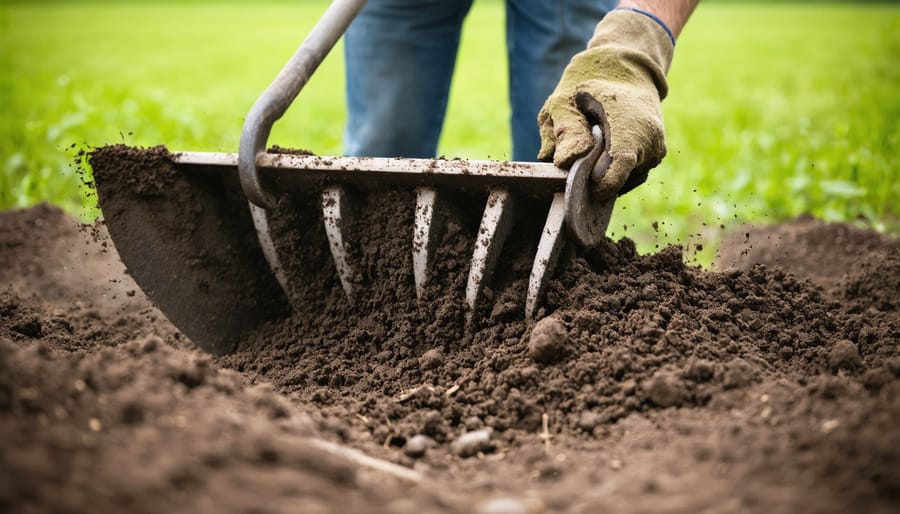
Maintenance and Care Tips
Cleaning and Storage
Proper maintenance of your 3-prong garden tool will significantly extend its lifespan and keep it working efficiently season after season. After each use, remove soil and debris by gently tapping the tines against a hard surface, then rinse with a garden hose. For stubborn dirt, use a stiff brush to clean between the prongs. Never put your tool away wet, as this can lead to rust – instead, thoroughly dry it with a clean cloth.
Before storage, apply a light coat of mineral oil or WD-40 to the metal parts to prevent rust. This is especially important if you live in a humid climate. The wooden handle should be periodically treated with linseed oil to prevent drying and cracking.
Store your 3-prong tool in a dry, covered area like a garden shed or garage. Hanging it on a tool rack keeps it organized and prevents the tines from becoming bent or damaged. During the off-season, perform a thorough cleaning and maintenance check to ensure your tool is ready for spring gardening.
Sharpening and Repairs
Regular maintenance of your three-prong garden tool will ensure its longevity and optimal performance. To maintain your garden tools effectively, start by cleaning the prongs after each use to prevent rust and soil buildup. Use a wire brush to remove stubborn dirt, followed by a light coating of mineral oil on the metal parts.
When the prongs become dull, sharpen them using a metal file, working at a 20-degree angle along the original beveled edge. Make smooth, consistent strokes away from your body, and ensure all prongs are sharpened evenly for balanced performance. If you notice any bent prongs, carefully straighten them using pliers while supporting the tool on a solid surface.
For wooden handles, sand down any rough spots or splinters, and apply linseed oil annually to prevent drying and cracking. If your handle becomes loose, tighten the mounting screws or replace them if they’re stripped. For serious damage like broken prongs or severely cracked handles, consider seeking professional repair or replacing the tool to ensure safe operation.
Store your tool in a dry place, hanging it if possible, to prevent moisture damage and maintain its shape. With proper care, your three-prong garden tool can serve you reliably for many years.
Modern Innovations and Ergonomic Designs
Today’s 3-prong cultivators have come a long way from their traditional counterparts, incorporating ergonomic designs and innovative features that make gardening more comfortable and efficient. Modern versions often feature cushioned, non-slip handles that reduce hand fatigue and provide better control during extended use. The introduction of lightweight yet durable materials like aluminum and reinforced composite plastics has made these tools more manageable without sacrificing strength.
Many manufacturers now offer adjustable handle lengths to accommodate gardeners of different heights, preventing back strain during use. Some models feature interchangeable heads, allowing you to switch between different tine configurations based on your specific gardening needs. The tines themselves have been reimagined with improved angles and spacing for optimal soil penetration and weed removal.
Another noteworthy innovation is the integration of shock-absorbing systems in premium models, which minimize vibration transfer to your hands and wrists. Some designs now include measurement markers on the tines to help maintain consistent planting depths, while others feature bright visibility colors to prevent misplacement in the garden.
For urban gardeners, compact folding designs have emerged, making storage easier in limited spaces. Additionally, manufacturers are increasingly using rust-resistant coatings and materials that extend tool life while requiring minimal maintenance, making these modern cultivators a smart investment for any gardener.
The 3-prong cultivator stands as an indispensable companion in every gardener’s toolkit, proving its worth through generations of use and continuing to adapt to modern gardening needs. Its versatility in breaking up soil, removing weeds, and aerating garden beds makes it a true workhorse that simplifies numerous gardening tasks. Whether you’re a weekend gardener tending to a small herb garden or managing extensive vegetable plots, this humble tool offers remarkable efficiency and precision in maintaining healthy, thriving gardens. The ergonomic design and durable construction of today’s cultivators ensure they’ll serve faithfully for years to come, making them a wise investment for any gardening enthusiast. As we embrace sustainable gardening practices, the 3-prong cultivator remains a perfect example of how traditional tools continue to support environmentally conscious cultivation methods while bringing joy and success to gardening endeavors.

